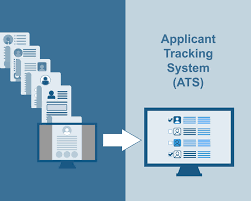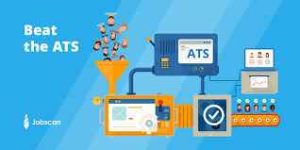Your Gateway To Landing Your Dream Job Through Applicant Tracking Systems (ATS)

In today’s competitive job market, landing your dream job isn’t possible only through qualifications, it also requires understanding how Applicant Tracking Systems (ATS) work. These digital systems are revolutionising the hiring process, helping employers sift through mountains of resumes to find the perfect match. Here’s everything you need to know about ATS, from how they work to staying ahead in your job search.
Land Your Job Through ATS
What Are Applicant Tracking Systems?
Applicant Tracking Systems are like the ultimate matchmakers for job seekers and employers. They use algorithms to scan resumes, cover letters, and applications for keywords that match the job description. According to a 2023 HR Tech Survey Report, over 75% of large companies in the US use ATS to manage their hiring processes. This means understanding how ATS operate is key to getting noticed by recruiters.
How Does an ATS Work?
Imagine ATS as your digital job application assistant. They automatically filter and rank incoming resumes based on specific criteria set by employers. For instance, if a job listing requires skills like “project management” or “digital marketing,” ATS will scan resumes for these keywords to find the best matches. This automated screening process saves recruiters time and helps them identify candidates who closely match the job requirements.
Tips To Stay Ahead Of The ATS
- Tailor Your Resume: Customise your resume for each job application by incorporating keywords from the job description. This not only helps ATS identify your relevance but also showcases your fit for the role.
- Use Simple Formatting: ATS algorithms may struggle with complex layouts or unusual fonts. Stick to a clean, straightforward resume format to ensure it’s easily readable by the system.
- Include Relevant Keywords: Sprinkle keywords naturally throughout your resume and cover letter. Use industry-specific terms and skills prominently to increase your chances of passing through ATS screenings.
- Avoid Over-Optimisation: While keywords are crucial, don’t overstuff your resume with them. Aim for a balance between relevance and readability to impress both ATS and human recruiters.
- Proofread Carefully: ATS can detect spelling errors and typos, which could negatively impact your application. Double-check your documents for accuracy before submitting them.
ATS And Keyword Optimisation
While keywords are essential for passing through ATS screenings, it’s crucial to use them strategically. ATS not only look for specific job-related keywords but also analyse context and relevance. Tailor your resume and cover letter to include relevant keywords naturally, reflecting your skills and experience in alignment with the job description. Here are a few examples to help you understand better:
- Job Title-Specific Keywords: For a marketing position, keywords might include “Marketing Specialist,” “Digital Marketing Manager,” or “SEO Expert.”
- Skills and Competencies: If you’re applying for a software development role, include skills like “JavaScript,” “Python,” “Agile methodologies,” and “Full-stack development.”
- Industry-Specific Terms: In finance, keywords might be “Financial Analysis,” “Budget Forecasting,” “CPA,” or “Risk Management.”
- Certifications and Degrees: For healthcare positions, you might need keywords like “Registered Nurse,” “BSN,” “ACLS certified,” or “Certified Medical Assistant.”
- Experience-Related Keywords: Use phrases like “5+ years in project management,” “Proven track record in sales,” or “Experience with client relations.”
The Importance Of ATS-Friendly Formatting
ATS algorithms prioritise readability and consistency. Opt for a clean, well-structured resume format with standard fonts (eg, Arial, Times New Roman) and clear section headings. Avoid using tables, columns, or graphics that could confuse ATS parsers. A simple layout ensures your information is parsed accurately, increasing your chances of getting noticed by recruiters.
ATS And Application Tracking
Beyond resume screening, ATS streamline the entire application tracking process. They manage candidate communications, track application statuses, and facilitate collaboration among hiring teams. This integrated approach helps employers manage large volumes of applications efficiently, ensuring a smoother hiring process from start to finish.
ATS And Candidate Experience
While ATS benefit employers by automating tasks, they also influence candidate experience. A user-friendly ATS interface enhances applicants’ interactions with potential employers, providing timely updates on application statuses and maintaining clear communication channels. Employers who prioritise a positive candidate experience through ATS can attract top talent and build a reputation as an employer of choice.
The Role Of ATS In Diversity And Inclusion
ATS have the potential to promote diversity and inclusion in hiring practices. By standardising candidate evaluations based on qualifications and skills, ATS minimises biases that can arise in manual resume reviews. However, it’s essential for employers to review and refine ATS algorithms regularly to ensure fairness and mitigate unintended biases that may impact diverse candidates.
Future Trends In ATS
According to a 2024 study from CareerBuilder, 98% of Fortune 500 companies use ATS for initial candidate screenings. This highlights the widespread adoption of ATS among large corporations, underscoring their importance in modern recruitment processes.
Looking ahead, ATS are expected to evolve with advancements in artificial intelligence and machine learning. Future trends may include enhanced predictive analytics to assess candidate fit, integration with video interviewing platforms, and improved customisation options for recruiters. Job seekers should stay informed about these developments to adapt their job search strategies effectively in a rapidly changing digital landscape.
Staying Relevant In The Job Market
In addition to understanding ATS, staying relevant in today’s job market requires proactive steps:
- Continuous Learning: Upskill or reskill to stay current with industry trends and technologies. Online courses, workshops, and certifications can enhance your qualifications and make you more attractive to employers.
- Networking: Build and maintain professional networks through platforms like LinkedIn, industry events, and informational interviews. Networking helps you uncover hidden job opportunities and get referrals, bypassing ATS in some cases.
- Personal Branding: Develop a strong online presence through a professional LinkedIn profile, a personal website showcasing your work, and active participation in relevant online communities. A consistent and positive online presence can boost your visibility to recruiters and hiring managers.
- Adaptability: Be open to new opportunities and flexible in your career trajectory. The job market is dynamic, and being adaptable can help you pivot quickly to new roles or industries as needed.
Beating The ATS
Navigating Applicant Tracking Systems doesn’t have to be daunting. By understanding how ATS works and optimising your job application strategies accordingly, you can increase your chances of landing interviews and ultimately, your dream job. Remember, ATS are tools designed to streamline the hiring process, and with the right approach, you can use them to your advantage. Stay proactive, keep learning, and showcase your skills effectively to stand out in today’s competitive job market.
Mentoria can help you make your application more ATS friendly. We can provide you with CV and LinkedIn revamps, helping your application stand out and land your dream job!










